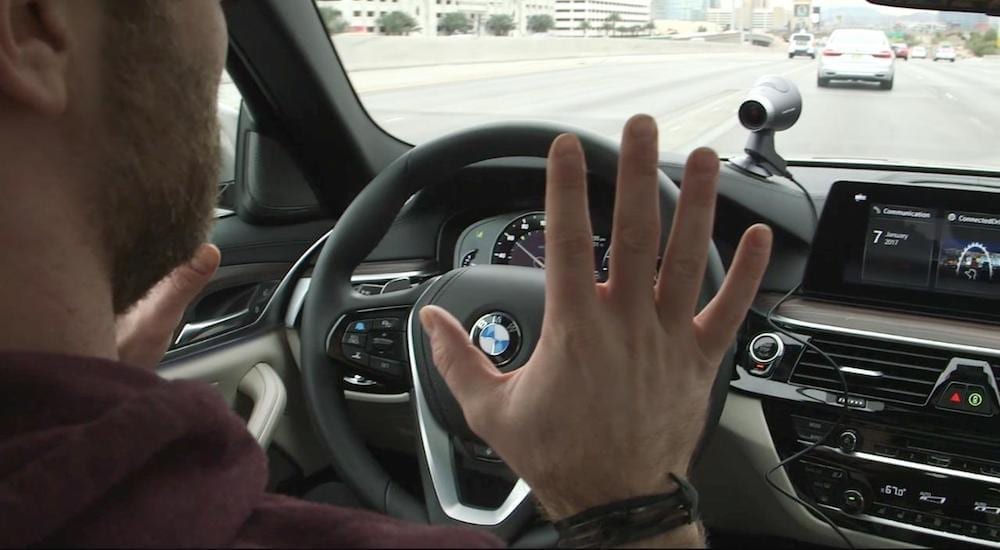Self-driving cars once seemed a distant speck on the horizon and were only featured in science fiction movies. But now, this piece of fiction has become a reality and is coming to life is many different ways. Autonomous, or self-driving, cars have existed for a while and are manufactured by various car companies. But in 2021, BMW is releasing a level three autonomous vehicle.
What defines an autonomous car?
Just because a vehicle is being advertised as autonomous does not mean that you are able to simply go along for the ride. There are five different levels of autonomous vehicles.
A level one autonomous car has features that assist the driver. These features typically consist of sensors and tools, such as a back-up camera. According to BMW’s website, all its vehicles include level one automation. These features include collision and pedestrian warning and automatic braking.
Next, there is a level two automated vehicle. A level two vehicle will have automated driving. Like a Level 1 vehicle, these features are safety measures. For example, a level two-vehicle, such the BMW 5-Series, comes equipped with self-parking capabilities.
Level three vehicles will allow you to take a break from the wheel. A level three vehicle allows the driver to take short periods of rest—but only during very specific situations. If you are trying to navigate your way through a construction zone, you will need to take over the wheel.
Moving up the scale, a level four autonomous vehicle is a fully autonomous car. If requested, though, the driver will be able to take control of the car.
Finally, a level five autonomous vehicle hands over total control of driving to the car. At this point, the driver would be a passenger while the vehicle navigates its way around. A level five autonomous vehicle will be able to wind its way through traffic during a commute or even on a long road trip. However, this level of autonomy is still far off into the future.
BMW’s New Reveal
This year, BMW debuted a new self-driving Series 5 vehicle. This Series 5 is capable of level three autonomous driving. With this vehicle, a driver will have the ability to take their hands off the wheel completely in different situations.
Included in this Series 5 is the Real-Time Traffic Light Information. This software stores data about traffic light timers. For example, the current model that is being tested in Las Vegas can tell how many seconds are left until the light changes. A timer is visible on the dashboard.
Also included in the car is new iDrive technology. The iDrive allows drivers to use gestures, rather than pressing multiple buttons, to perform different tasks. These tasks include operations such as finding a radio station or navigating your way to a new restaurant in town. BMWs already come equipped with this feature, but the level three Series 5 promises improved performance.
Amazon Prime and Cortana software are also included in the automated Series 5. This technology can tell you travel times and review a personal schedule or itinerary. The Amazon Prime feature lets you order provisions and have them delivered to you somewhere along your route.
While the vehicle is self-driving, there are many things the drivers will be able to do while at the helm. Possibilities include watching a movie or getting information about places and attractions you pass. The automated ride allows the driver to, at many points, be a passenger and not worry about the stress of dealing with traffic.
How Much You Should Expect to Pay
There is not much information available yet on the exact cost, but currently, the MSRP for a new 2018 530i Sedan is $52,650. Some experts from IHS Automotive predict the self-driving technology in autonomous cars could add anywhere from $7,000 to $10,000 to the base price.
Low-cost alternatives for the technology used in these cars are being researched, according to co-founder and chief executive Ziv Aviram of the company Mobileye. Mobileye works with BMW, General Motors, and Volvo.
Worried About Safety?
A survey from AAA, the American Automobile Association, reveals many Americans don’t particularly enjoy the idea of self-driving cars. Millennials seem to be the ones most interested in this technology, according to the survey. Additionally, the survey said 78 percent of Americans are afraid to ride in a self-driving car.
And of course, people have doubts whether or not autonomous cars are going to be safe. If you live in a major city with a commute along the freeway, you’re no stranger to traffic jams and rubberneckers clogging up the lanes in an accident. Autonomous cars are designed to help prevent these accidents.
Automakers are doing everything they can to ensure these vehicles meet safety standards. States today have their own guidelines in place. Congress is currently working on creating rules and regulations that will apply to all 50 states. These rules will ensure protection for consumers.
Dilemmas Pose Problems to Automakers
While autonomous cars are built with safety in mind, other questions may lurk in the minds of consumers and carmakers.
How do lawmakers go about setting regulations that can allow for drivers, passengers, and other surrounding vehicles to be safe while also allowing for engineers to have freedom in their designs? Having regulations based on safety concerns will ease the minds of many Americans, but it may also discourage innovation if the laws are too constraining.
How will these vehicles perform in various weather? If it is raining buckets or there is strong wind steering your vehicle off the road, the car should be able to withstand the test.
What’s Next for BMW
BMW plans on unveiling a final version of its new autonomous vehicle in 2021. In the meantime, BMW will continue to make changes through its testing to improve the vehicle and the level three autonomous features.
BMW is not only stepping up their game when it comes to self-driving cars. The company is also going to have at least 12 fully electric cars by 2025 to rival their competition.




